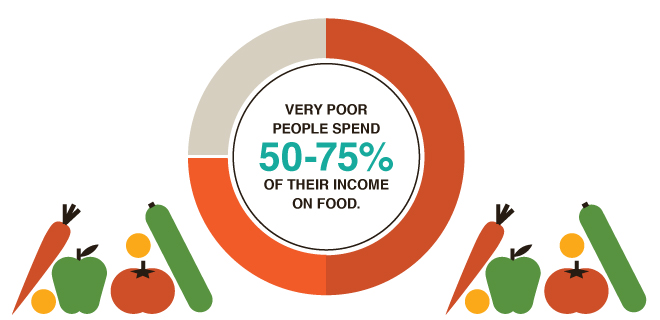Food Prices

Facts
- Food expenditures account for 20–50% or more of household budgets in many low- and middle income countries (OECD-FAO 2013 p. 19).
- Price fluctuations are a common feature of well-functioning agricultural product markets. But when these become large and unexpected—volatile—they can reduce the food security of consumers, farmers and entire countries.
- Since 2007, world markets have seen a series of dramatic swings in commodity prices. Food prices reached their highest levels for 30 years during the summer of 2008, collapsed the following winter, and rose rapidly again in the months that followed. Food prices today remain high, and are expected to remain volatile (FAO 2013a).
- The link between commodity prices and what consumers actually pay for their food is usually not straightforward. So, even though commodity prices remain high, there is some evidence that consumer food price inflation is abating. Nevertheless, with food expenditures accounting for such a high proportion of household budgets in many low- and middle-income countries, food affordability remains a concern (OECD–FAO 2013 p. 19).
Sources and further reading
- [FAO] Food and Agriculture Organization of the United Nations. 2012. Price volatility from a global perspective. Rome: FAO. (Available from http://www.fao.org/fileadmin/templates/est/meetings/price_volatility/Price_volatility_TechPaper_V3_clean.pdf)
- [FAO] Food and Agriculture Organization of the United Nations. 2013a. Price volatility in agricultural markets [webpage]. http://www.fao.org/economic/est/issues/volatility/en/ (Accessed on 6 November 2013)
- [FAO] Food and Agriculture Organization of the United Nations. 2013a. Food outlook: Biannual report on global food markets. June 2013. Rome: FAO. (http://www.fao.org/docrep/018/al999e/al999e.pdf)
- [FAO] Food and Agriculture Organization of the United Nations. 2013b. FAO food price index [webpage]. http://www.fao.org/worldfoodsituation/foodpricesindex/en/ (Accessed on 6 November 2013)
- [FAO] Food and Agriculture Organization of the United Nations. 2013c. FAO cereal supply and demand brief [webpage]. http://www.fao.org/worldfoodsituation/csdb/en/ (Accessed on 6 November 2013)
- [FAO] Food and Agriculture Organization of the United Nations. 2013d. FAO price volatility [webpage]. http://www.fao.org/economic/est/issues/volatility/en/ (Accessed on 6 November 2013)
- [FAO] Food and Agriculture Organization of the United Nations. 2013e. Food outlook: Biannual report on global food markets. June 2013. Rome: FAO. (Available from http://www.fao.org/docrep/018/al999e/al999e.pdf)
- [OECD-FAO] Organisation for Economic Co-operation and Development-Food and Agriculture Organization of the United Nations. 2013. OECD-FAO agricultural outlook 2013. Paris: OECD and Rome:FAO. (Available from http://dx.doi.org/10.1787/agr_outlook-2013-en) (Accessed on 6 November 2013)